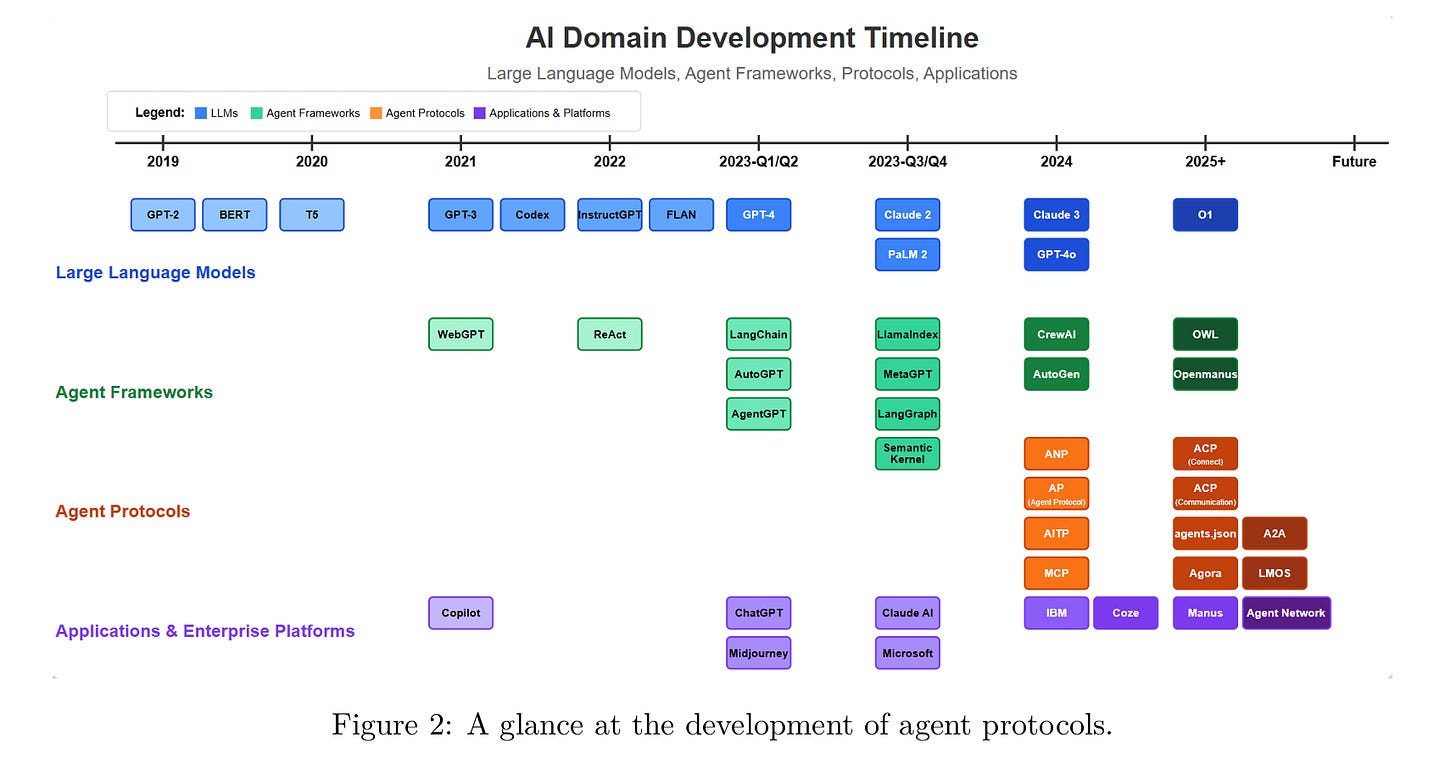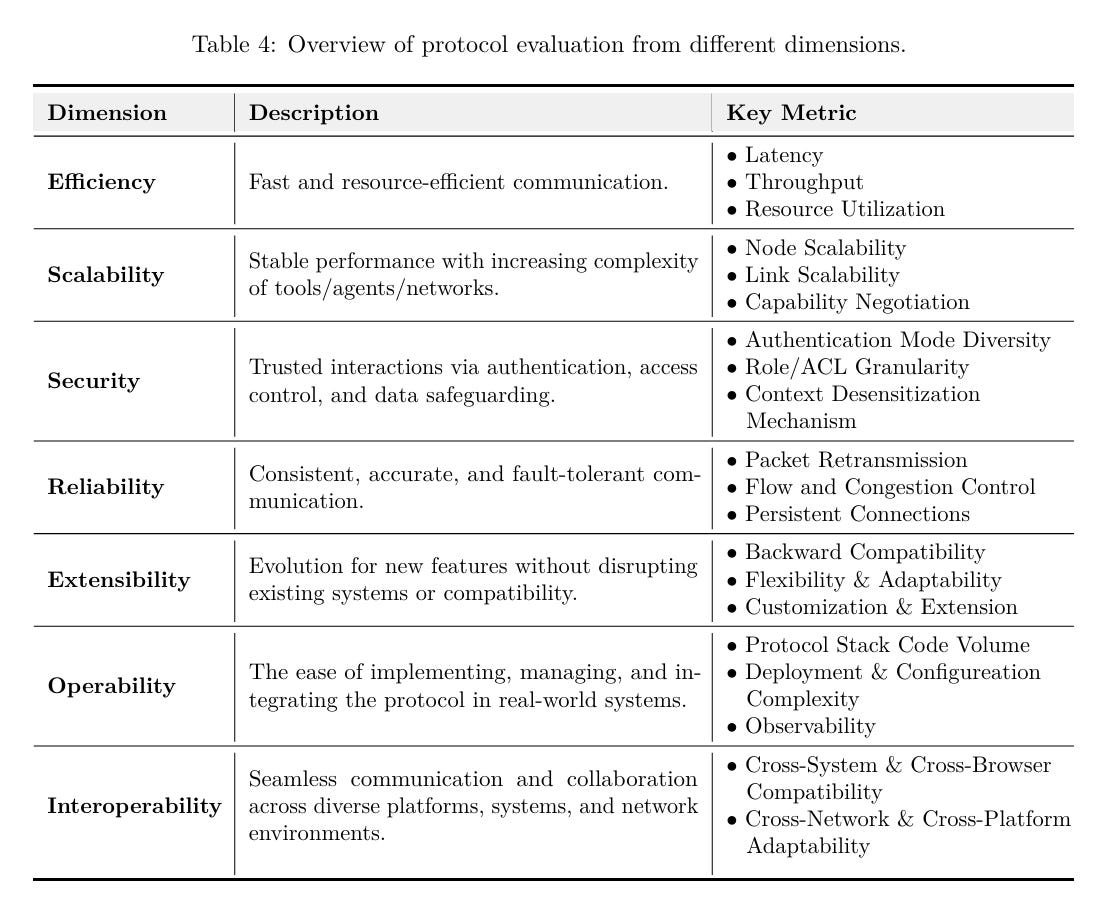How AI Agents Chat? And Why It Matters?
Standardizing AI Agents: A Deep Dive into Protocols and Possibilities ⚡
As large language models (LLMs) keep changing industries from customer support to healthcare, the emergence of LLM-based agents is opening a new chapter in AI. These agents can make decisions on their own, reason through problems, and use external tools, which is changing how we handle complex tasks. But there’s a big problem holding things back: there’s no standard way for these agents to talk to each other or the tools they rely on. Without a shared communication framework, agents can’t easily work together or scale, which kills their potential for collaboration. In this post, I’ll break down the current state of AI agent protocols, based on a detailed survey done by researchers at Shanghai Jiao Tong University and the ANP Community. We’ll go through how they’ve categorized the protocols, what performance metrics they use, different use cases, and what the future might look like for protocol-driven agent ecosystems.
🔍 Why Standardized Protocols for AI Agents Matter
The explosion of LLM agents across different industries has made one thing clear: the communication landscape is fragmented. The survey points this out, comparing today’s situation to the early days of the Internet before TCP/IP and HTTP came in to connect everything. Right now, LLM agents are stuck in their own silos, using proprietary standards and incompatible interfaces, which makes collaboration and integration a pain. A universal protocol could change all that, letting agents connect with tools and each other to form networks of intelligence that work together in ways individual agents never could.
The survey draws a strong parallel to how the Internet evolved. Just like the Internet unlocked global connectivity, a well-designed agent protocol could create a system where specialized agents collaborate dynamically. Picture this: a healthcare agent pulls patient data from an external API, then teams up with a diagnostic agent to come up with insights that neither could manage alone. That’s the big-picture goal behind standardizing protocols, and the survey dives deep into the current state of things and where it’s all headed.
📃 Classifying Agent Protocols: A Two-Dimensional Framework
To make sense of the growing variety of agent protocols, the survey suggests a two-axis classification: one based on the protocol’s orientation (context vs. inter-agent), and the other based on application scope (general-purpose vs. domain-specific). This setup helps developers figure out which protocol fits their use case.
Context-Oriented Protocols
These are designed to help agents access external data (like APIs or tools) to answer more complex questions. For example, if an agent is asked about the weather, it might call a real-time weather API. One standout mentioned in the survey is Anthropic’s Model Context Protocol (MCP), which acts like an “external brain” to boost what the agent knows. These protocols break down further into:
General-Purpose: Stuff like MCP or Agent Communication Protocol (ACP) can handle a bunch of different tasks from weather lookups to data analysis, by offering flexible tool interfaces.
Domain-Specific: Protocols like Agent Interaction & Transaction Protocol (AITP) are made for specific areas, like blockchain-based workflows or financial transactions.
The biggest hurdle for context-oriented protocols? Fragmentation. Every LLM provider does things their own way, and tools all have different interfaces. That means more dev time, more custom work, and a clear need for standardized setups to make things smoother.
Inter-Agent Protocols
These focus on letting agents work together, share data, and coordinate tasks, especially important in multi-agent systems. The survey gives a few examples:
General-Purpose: Agent Network Protocol (ANP) is built for decentralized, cross-domain use great for big projects involving multiple organizations.
Domain-Specific: Google’s Agent-to-Agent (A2A) protocol is aimed at enterprise environments, letting agents securely talk within company boundaries.
Protocols like ANP and A2A help solve real problems around scale and trust in agent collaboration, especially when different vendors or organizations are involved.
⚡ How the Survey Measures Protocol Performance
To help developers choose the right protocol, the survey lays out seven core performance dimensions: efficiency, scalability, security, reliability, extensibility, operability, and interoperability. Each one comes with specific metrics to make comparisons more concrete 👇
Efficiency
This is all about how fast and resource-light a protocol is during communication. Key metrics include:
Latency: How long it takes to send a message.
Throughput: How many messages it can handle per second (TPS-N = #Processed Messages / Elapsed Time).
Resource Use: How much CPU, RAM, bandwidth, and tokens the protocol consumes when LLMs are doing their thing.
For instance, MCP uses HTTP Streaming to boost transfer speed, but this can also increase latency. Something developers need to fine-tune.
Scalability
Scalability looks at how well a protocol handles growing demand whether that’s more agents, tools, or connections. Metrics here include:
Node Scalability: Performance as more agents/tools get added.
Link Scalability: Performance as communication links become more dense.
Capability Negotiation Score (CNS): How good the protocol is at dynamic feature agreements. It’s calculated as CNS = (#Successful Negotiations / #Negotiation Attempts) / Average Negotiation Time.
ANP shines here thanks to its decentralized setup, which works well with lots of agents. A2A, on the other hand, is optimized for tight, internal enterprise use where link density is higher.
Security
Security is super important, especially when agents are working with sensitive data like in healthcare. Here's how we measure it:
Authentication Mode Diversity: How many types of login/authentication methods the protocol supports.
Role/ACL Granularity: How detailed the access control is who can do what exactly.
Context Desensitization: Stuff like data masking that hides sensitive info during processing.
A2A is great for secure internal use with its enterprise-grade authentication and role-based access controls. On the other hand, ANP is solid for working across organizations thanks to W3C Decentralized Identifiers (DID).
Reliability
Reliable agent communication means messages get delivered correctly and on time. Here’s how it’s measured:
Automatic Retry Count (ARC): How many times it retries sending failed messages.
Convergence Time (CT): How quickly it adjusts to network changes.
Unexpected Disconnection Rate (UDR) & Message-Loss Rate (MLR): How often it disconnects or loses messages.
Protocols like ACP bring in TCP-style retransmissions and flow control, so they can handle unstable network environments without breaking a sweat.
Extensibility
Extensibility is all about how easy it is to add new stuff to a protocol without breaking existing things. These are the metrics:
Upgrade Success Rate (USR): Do older clients still work after updates?
Automatic Test Pass Rate (ATPR): How many new features pass automated testing.
Customization: Can you add custom fields or plugins?
MCP is a good example, it moved from v1.0 to v1.2 with things like HTTP Streaming and authentication added, all while staying compatible with older versions.
Operability
Operability looks at how easy it is to build, run, and maintain the protocol. Metrics include:
Number of Dependency Components (NDC): How many external things you need to make it work.
Protocol Stack Code Volume: How big and complex the codebase is.
Observability: Does it have tools for monitoring and debugging?
ACP wins in simplicity with its clean API and good SDKs. ANP scores high too by offering detailed observability tools.
Interoperability
Interoperability is about how well the protocol plays with others different systems, browsers, networks, etc. Key metrics:
Schema Compatibility Test Pass Rate (SCTPR): Does it understand different data schemas?
Cross-System/Browser Compatibility: Does it work across devices and browsers?
Cross-Network/Platform Adaptability: Can it run on LANs, WANs, different programming languages?
ANP leads in cross-domain setups, making it perfect for collaboration between different orgs. A2A focuses more on internal enterprise needs but is still solid across platforms.
✈️ Use-Case Breakdown: Planning a Five-Day Trip
To make all of this less abstract, let’s walk through a real-world use case planning a five-day trip from Beijing to New York. Here's how the four protocols handle it:
MCP – Centralized Coordination
One agent does everything flights, hotels, weather. It’s easy to manage but becomes a bottleneck quickly.A2A – Distributed Enterprise Collaboration
Different agents (Flight, Hotel, Weather) talk directly to each other. That reduces overhead and improves flexibility.ANP – Cross-Domain Negotiation
Different companies (airline, hotel, weather site) communicate through standard protocols. The main Travel Planner coordinates but doesn't control every step.Agora – Natural Language to Protocol
You speak naturally, and it converts that into structured protocol actions for agents. Super user-friendly, but depends heavily on strong language understanding.
Each one shines in a specific area, MCP for centralized tasks, A2A for internal enterprise ops, ANP for collaborations between companies, and Agora for a smoother user experience.
👓 The Future of Agent Protocols
The future of agent protocols is being shaped right now, and it's looking exciting. Here's how things might evolve:
Short-Term: Evolvable Protocols
Better evaluation tools (benchmarks for performance and robustness).
Privacy-preserving mechanisms like attribute-based access or federated learning.
Group-based communication with things like Agent Mesh Protocols.
Learnable protocols that adjust to new tasks on the fly.
Mid-Term: Layered Designs
Train LLMs to understand and use protocols natively.
Modular protocol architecture, separating transport, sync, semantics.
Built-in support for ethical/legal constraints.
Long-Term: Collective Intelligence
Understand how more agents + smarter communication = better results.
Build infrastructure for agent data networks that sync over long periods and manage complex plans.
🧠 Final Thoughts
AI agent protocols are kind of like the internet standards from back in the day, they’re becoming the invisible glue that holds everything together. This survey breaks it down into real, actionable insights by classifying, evaluating, and comparing real-world use cases.
The big takeaway? Choose protocols that match your use case, keep an eye on security and reliability, and stay ready for the next wave of evolvable, privacy-aware systems. If agents are going to work together at scale, strong protocols are what’s going to make it happen.








